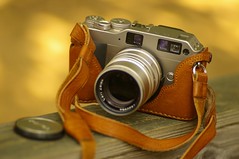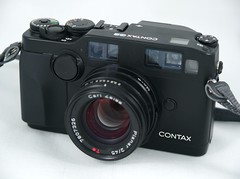Contax G1[]
See also the article Contax G1

|
| Contax G1 |
In 1994, Contax introduced an apparent oddity: a new line of interchangeable-lens rangefinder cameras that did not use the established Leica-M or Leica-screw lens mounts. The new camera, the Contax G1, used the "G"-mount, an electronic autofocus mount. Critics were quick to accuse the camera of not being a "true" (mechanical) rangefinder, since it used autofocus and electronically-linked mechanisms. But the AF mechanism in the G1, and later the G2 (introduced in 1996), does indeed use a twin-window system much like that of the older mechanical rangefinders—only in electronic form. An advantage of the Contax G finders over other rangefinder cameras is the fact that with lenses from 28mm to 90mm they always show the correct view (zoom rangefinders). The same is true for close focusing, as they also feature parallax correction. Some users reported focusing problems with the Contax G1 at close distances with the 90mm Sonnar and Contax introduced the successor to the Contax G1, the G2, only two years after its introduction in 1996.
|
| ||||
| Contax G1 with Carl Zeiss Planar 45mm f/2 and Carl Zeiss Sonnar 90mm f2.8. Images by Süleyman Demir
Images by Süleyman Demir (Image rights) | |||||
Contax G2[]
The successor to the G1, the Contax G2, has improved autofocus performance and a series of new features and ergonomic enhancements. The manual focus wheel was moved from the top deck to the front, to about the same position as where the focusing wheel was located on classic Dresden and Stuttgart Contax rangefinders. The G2 also has two AF modes - continuous, which constantly adjusts focus as the camera is moved, and single, which is a safety mode, focusing as the focus button is pressed, (or shutter release half-pressed) and maintaining this reading until the shutter is released. If the camera fails to find focus in this mode, the shutter cannot be released. The body size and weight increased slightly over the Contax G1. The Contax GD-2 data back can be attached to the Contax G2. It is one of the most sophisticated data backs ever made by any camera manufacturer and features inbetween frame recording of data as well as a Contax-specific recording mode of the exposure data on the first two frames of the film after the last picture has been taken. Initially the Contax G2 was manufactured in Titanium color, a so-called "Millenium Edition" in black color exists as well. There are two versions of the black model, one using paint, and the more preferred black chrome..
G1 vs G2[]
The G2 addresses some of the criticisms of the G1, especially with regard to its focusing system. The G1 uses only a passive autofocus "phase detection" system. In this system two CCD arrays achieve focus by minimizing differences in patterns from the physically separated dual array sets. It is extremely accurate under the right conditions, but slow and inaccurate in low light as well as close up photography. The G2 adds an active focusing component that uses infrared beams and triangulation. It combines both technologies to achieve a faster more accurate focusing system. In addition, the G2 has a wider rangefinder base and a higher top-speed of 1/4000 sec in manual mode, 1/6000 sec in aperture priority mode.

|
| Black model Contax G2 |
Contax G Lenses[]
The lenses made by Kyocera under license from Zeiss for the G-series quickly established it as a contender: the original 45mm f/2 Planar was joined by a 28mm f/2.8 Biogon and a 90mm f/2.8 Sonnar; a 21 f/2.8 Biogon, 16mm f/8 Hologon (manufactured in Germany by Carl Zeiss and a 35mm f/2 Planar, as well as a 35-70mm f/3.5-5.6 Vario Sonnar were added later. The 45mm Planar in particular gained renown as the sharpest 35mm camera lens ever tested by the Swedish test site Photodo — outclassing even the illustrious Leica 50mm Summicron. Zoerkendoerfer in Munich Germany also modified the Voigtländer 12mm f/5.6 Ultra-Wide Heliar and the 15mm f/4.5 Super-Wide Heliar for use with the Contax G mount.
|
| ||||
| Carl Zeiss Planar 45mm f/2 & Sonnar 90mm f/2.8 Images by Süleyman Demir
Images by Süleyman Demir (Image rights) | |||||
G1/G2 Lens Compatibility[]
The original Contax G1 is not compatible with the 21mm, 35mm and 35-70mm lenses[1]. Contax provided a firmware upgrade for many of these cameras. Such upgraded G1s may be identified by a green-colored sticker in the film chamber. It is not possible to use the 35-70 zoom lens on the Contax G1 even with the upgrade, as the G1 mount lacks the electronic interface for it.
Flash compatibility[]
Both camera models feature TTL/OTF capability and are compatible with the Contax TLA flash system. The Contax TLA140 and TLA 200 flashes were specifically designed for the Contax G series, but other flashes, especially the Contax TLA 280 and TLA 360 also work well with these models. Multi-flash cords are available and up to six Contax TLA-compatible flashes can be controlled from a single camera simultaneously.
|
| ||||
| Contax G1 & Contax TLA140 Images by Süleyman Demir
Images by Süleyman Demir (Image rights) | |||||
The End of the Contax Production[]
In 2005, Kyocera announced it would cease all activity related to the manufacture of Contax cameras at the end of the year, effectively spelling the end of the G system. Carl Zeiss also worked in conjunction with Cosina, the producer of a line of Leica M mount and screw mount clones to provide Leica M mount Zeiss lenses, as well as a manual focus rangefinder camera, the Zeiss Ikon, developed by Zeiss and manufactured in Japan by Cosina.
Recommendation[]
With its titanium clad body, sophisticated electronic rangefinder and superb lenses, the G system has not been equalled in the years since its introduction. To its fans, the Contax G2 is the finest 35mm camera ever produced. The Contax G system is still available in quantities in the used camera market at prices much below the Leica M system. Users who do not need lenses faster than f/2.0 will find that the Contax G system is still unmatched in camera performance with lens quality equaling the Leica M performance in most cases.
Links[]
- The Contax G Pages
- The Contax G User Pages
- Contax G at Wikipedia
- Contax G Price and Information Guide at www.antiquecameras.net
- How to use Contax G Focusing
- Kyocera North America
- Contax G1 Focusing System Information
- Contax G1 at Michael Elliott Photography
- Contaxinfo.com: Contax User Forum, MTF Lens-Data, scanned broschures, user manuals, user images etc.
- Contax G1 Statistic Price Info's at AuctionPriceTracker (English)
- Contax G1 Statistic Price Info's at AuctionPriceTracker (German)
- Contax G1 Statistic Price Info's at AuctionPriceTracker (Italian)
- Contax G2 Statistic Price Info's at AuctionPriceTracker (English)
- Contax G2 Statistic Price Info's at AuctionPriceTracker (German)
- Contax G2 Statistic Price Info's at AuctionPriceTracker (Italian)





